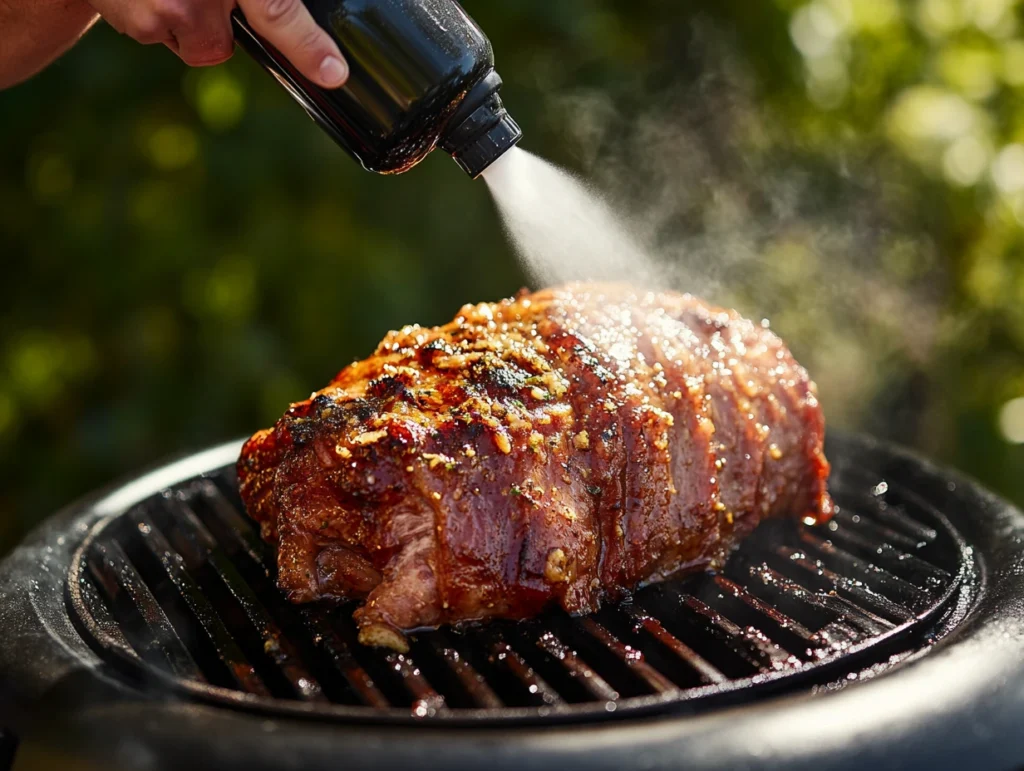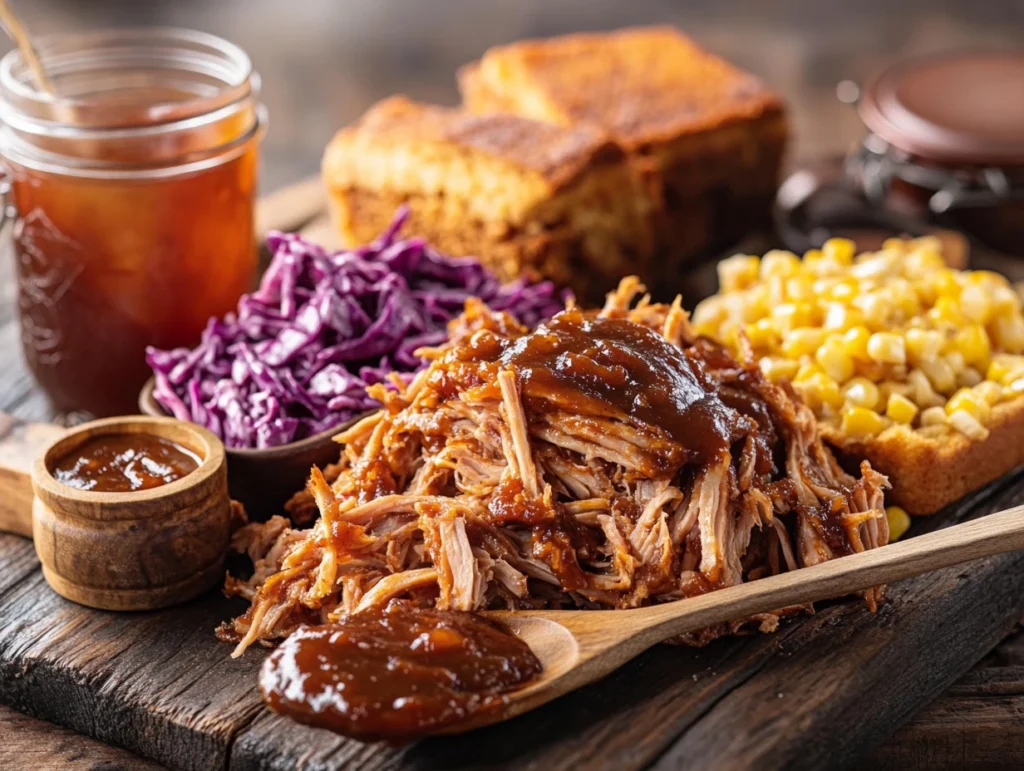Traeger Recipes: Pulled pork is the heart and soul of BBQ cuisine. It’s a dish that brings people together, whether it’s for a backyard gathering, a cozy family dinner, or meal prep for the week. Pulled pork is beloved for its juicy tenderness and rich smoky flavor, making it a favorite across all age groups and cooking skill levels. With the right technique, it can be elevated into something extraordinary, and this guide is here to help you achieve just that.
When it comes to smoking pulled pork, using a Traeger grill is a game-changer. Known for their precision and innovative design, Traeger grills have revolutionized the art of outdoor cooking. With their wood pellet technology, they infuse your food with a deep, smoky flavor that is impossible to achieve with gas or charcoal grills. If you’ve struggled with inconsistent results or feel overwhelmed by the complexities of smoking meat, Traeger makes it approachable, ensuring that every cook is a success.
In this ultimate guide, you’ll learn everything you need to know to create pulled pork that will impress even the most seasoned BBQ enthusiasts. From selecting the best cut of meat and mastering temperature control to choosing the perfect BBQ sauce and side dishes, this guide covers it all. Let’s get started and transform your cooking experience into a journey of flavor and joy.
Why Choose Traeger for Pulled Pork?
Smoking meat requires the right tools, and Traeger grills are at the forefront of modern BBQ equipment. Their innovative approach to wood-fired cooking sets them apart, making them an essential choice for pulled pork enthusiasts.
Unparalleled Wood-Fired Flavor
One of the key reasons to choose a Traeger grill is the flavor it imparts to your food. Traeger grills use 100% hardwood pellets to create smoke, and the type of wood you select can dramatically influence the flavor of your pulled pork. For example, pecan pellets add a warm, nutty undertone, while applewood delivers a delicate sweetness that pairs beautifully with pork. This natural wood-fired flavor is difficult to replicate with gas or charcoal grills, which lack the subtlety and complexity that wood smoke brings.
Consistent Temperature Control
Traeger grills shine when it comes to maintaining a steady temperature. Smoking pulled pork requires a low and slow approach, typically around 250°F for hours at a time. Traditional grills can be challenging to manage for this purpose, with fluctuating temperatures that can lead to uneven cooking. Traeger’s advanced temperature control technology ensures a steady heat throughout the cooking process, giving you perfect results every time.
Ease of Use for All Skill Levels
Traeger grills are designed to simplify the cooking process, making them ideal for both beginners and seasoned pros. With features like automated pellet feeding and the Traeger App, you can easily monitor the grill’s performance, adjust settings remotely, and access step-by-step recipes. These features allow you to focus on the fun parts of BBQ—tasting and sharing your creations.
If you’re eager to dive deeper into the world of smoked meats, the Comprehensive Guide to Smoking Meats is an excellent resource to expand your knowledge.
Prep and Cook Time
Patience is the secret ingredient in making exceptional pulled pork. The process of smoking meat is not one you can rush; the “low and slow” method ensures the meat becomes tender and flavorful.
- Preparation Time: 15 minutes
- Cooking Time: Approximately 9 hours
- Resting Time: 30 minutes
While the cooking time may seem long, remember that much of it is hands-off, allowing the grill to do the hard work. The result is well worth the wait: pulled pork that’s tender enough to shred with a fork and bursting with smoky goodness.
Ingredients for Perfect Pulled Pork
Achieving mouthwatering pulled pork starts with choosing high-quality ingredients. Simplicity is key, as the right ingredients will let the natural flavors shine.
Essential Ingredients
- Pork Butt (Boston Butt): This cut of meat is ideal for pulled pork due to its marbled fat content, which melts down during the cooking process to keep the meat juicy.
- Dry Rub: A mix of spices like paprika, garlic powder, onion powder, kosher salt, black pepper, and brown sugar creates a flavorful crust on the pork.
- Apple Cider Vinegar: Used for spritzing during cooking, it keeps the pork moist and adds a subtle tang that enhances the smoky flavor.
- BBQ Sauce: Sweet, tangy, or spicy BBQ sauce is the final touch that ties all the flavors together.
Optional Ingredients
- Butter and Honey: These can be added during the wrapping phase for extra richness and sweetness.
- Wood Pellets: Pecan and applewood are top choices, but hickory or cherry can also be used for unique flavor profiles.
Equipment Checklist
Before firing up your Traeger grill, make sure you have all the necessary equipment. Having the right tools at hand ensures a smooth cooking process and helps you achieve consistent results.
- Traeger Grill: Obviously, the star of the show.
- Meat Thermometer: Essential for monitoring the internal temperature of the pork. A wireless thermometer allows you to check the temperature without opening the grill lid, helping to maintain consistent heat.
- Heavy-Duty Aluminum Foil: Used to wrap the pork during the cooking process, ensuring it stays moist.
- Cutting Board and Sharp Knife: For trimming the pork before cooking and shredding it afterward.
- Spritz Bottle: Perfect for applying apple cider vinegar or other liquids to keep the meat moist.
- Grill Tools: Tongs, a basting brush, and a spatula are all helpful for handling the pork and applying rubs or sauces.
If you’re new to Traeger grills, the Grilling Recipes and Tips page is a great place to start learning about essential techniques and tools.
Step-by-Step Cooking Instructions

Making pulled pork on a Traeger grill involves several critical steps. Each one contributes to the final dish’s flavor, texture, and overall success.
1. Preparing the Pork
Start by selecting a high-quality pork butt, ideally one with a good balance of fat and lean meat. Trim any excess fat, leaving a thin layer to keep the meat moist during cooking. Next, generously apply the dry rub, ensuring that it covers every surface of the pork. Let the pork sit at room temperature for about 30 minutes to allow the flavors to penetrate the meat.
2. Setting Up the Traeger Grill
Preheat your Traeger grill to 250°F and load the hopper with your chosen wood pellets. Pecan and applewood are excellent options for pulled pork. Place a water pan in the grill to maintain a moist cooking environment, which is crucial for achieving tender meat.
3. Smoking the Pork
Place the pork butt directly on the grill grates, fat side up. This allows the fat to render down and baste the meat as it cooks. Close the lid and let the Traeger work its magic. Every hour or so, spritz the pork with apple cider vinegar to prevent the surface from drying out and to enhance the smoky flavor.
4. Wrapping and Finishing
Once the pork reaches an internal temperature of 165°F, remove it from the grill and wrap it tightly in aluminum foil. Add a splash of apple cider vinegar, butter, or honey before sealing the foil. This step, often referred to as the “Texas Crutch,” helps to lock in moisture and speeds up the cooking process. Return the wrapped pork to the grill and continue cooking until the internal temperature reaches 203°F.
5. Resting and Shredding
Allow the pork to rest in the foil for at least 30 minutes after removing it from the grill. This resting period lets the juices redistribute throughout the meat, making it even more tender. Once rested, shred the pork using meat claws or two forks. Mix it with your favorite BBQ sauce, or serve it plain for guests to customize.
Tips for Achieving Smoky Perfection
- Use the Right Pellets: Experiment with different wood pellets to find your preferred flavor combination.
- Monitor Temperatures Closely: A consistent cooking temperature is key to even results.
- Don’t Skip the Rest: Resting allows the meat to reabsorb its juices, enhancing both flavor and texture.
For more insights on safe cooking practices, visit Safe Meat Cooking Temperatures to ensure perfect results every time.
Best BBQ Sauce Pairings for Pulled Pork
Pulled pork is incredibly versatile, and the right BBQ sauce can enhance its flavor in unique ways.
- Sweet Sauces: A molasses-based sauce with hints of brown sugar pairs perfectly with the smoky richness of pulled pork.
- Spicy Sauces: Add some heat with a chipotle or jalapeño-infused sauce.
- Tangy Sauces: Mustard-based sauces bring a zesty, balanced flavor to the table.
Homemade sauces are easy to prepare and allow you to tailor the flavor to your liking.
Side Dish Ideas to Complement Pulled Pork
No pulled pork meal is complete without delicious side dishes. Here are some classic and creative options:
- Coleslaw: A creamy, tangy slaw provides a refreshing contrast to the smoky meat.
- Cornbread: Sweet and buttery cornbread is a perfect companion to pulled pork.
- Grilled Vegetables: Light, charred veggies like zucchini or asparagus add a healthy balance.
- Baked Beans: Smoky, savory beans are a staple of any BBQ spread.
Pair these sides with an ice-cold beer or a refreshing lemonade for a truly satisfying meal.
Storing and Reheating Pulled Pork
To make the most of your pulled pork, proper storage and reheating are essential. Store leftovers in an airtight container in the fridge for up to four days or freeze them for up to three months. To reheat, add a splash of broth or BBQ sauce and warm it in a covered dish to retain moisture.
Leftover pulled pork can be transformed into tacos, sliders, or even a topping for pizza or baked potatoes.
Common Mistakes to Avoid
- Over-Smoking: Too much smoke can overpower the meat’s natural flavor.
- Skipping the Resting Period: Resting is essential for juicy, flavorful meat.
- Inconsistent Temperatures: Fluctuations can lead to uneven cooking, so keep a close eye on your grill.
Recommended Products for Pulled Pork Success
To ensure your pulled pork is a hit, consider these tools and ingredients:
- Wood Pellets: Traeger Pecan and Applewood Pellets are highly recommended.
- Seasonings: Traeger Pork and Poultry Rub adds a flavorful kick.
- Accessories: A high-quality meat thermometer and heavy-duty foil are must-haves.
For more inspiration, Explore more Traeger recipes for BBQ tri-tip, ribs, and pulled pork.
Conclusion

Making pulled pork on a Traeger grill is a rewarding experience that combines flavor, technique, and creativity. By following this guide, you can create a dish that’s sure to impress your family and friends, whether it’s a casual dinner or a special celebration. Take your time, savor the process, and don’t be afraid to experiment with flavors to make it your own.
